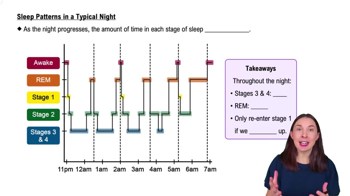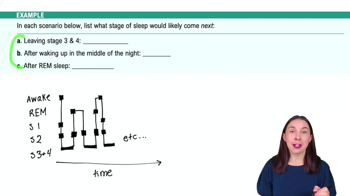Table of contents
- 1. Introduction to Psychology1h 43m
- 2. Psychology Research2h 20m
- 3. Biological Psychology2h 41m
- 4. Sensation and Perception28m
- 5. Consciousness and Sleep32m
- 6. Learning41m
- 7. Memory34m
- 8. Cognition37m
- 9. Emotion and Motivation35m
- 10. Developmental Psychology33m
- 11. Personality48m
- 12. Social Psychology41m
- 13. Stress and Health41m
- 14. Psychological Disorders44m
- 15. Treatment47m
5. Consciousness and Sleep
Sleep
Struggling with Psychology?
Join thousands of students who trust us to help them ace their exams!Watch the first videoMultiple Choice
Nearly _____ percent of a baby's sleep is REM, compared to about _____ percent for a normal, healthy adult.
A
10; 90
B
20; 50
C
50; 20
D
90; 10
 Verified step by step guidance
Verified step by step guidance1
Understand the concept of REM sleep: REM (Rapid Eye Movement) sleep is a unique phase of sleep characterized by rapid movement of the eyes, low muscle tone, and vivid dreams. It is crucial for cognitive functions and memory consolidation.
Recognize the differences in sleep patterns between infants and adults: Infants spend a larger proportion of their sleep in the REM phase compared to adults.
Recall typical REM sleep percentages: For adults, REM sleep typically constitutes about 20-25% of their total sleep time.
Consider the developmental needs of infants: Babies require more REM sleep for brain development, which is why a significant portion of their sleep is REM.
Apply this knowledge to the problem: Given the options, identify that nearly 50% of a baby's sleep is REM, while for adults, it is about 20%.

 3:25m
3:25mWatch next
Master Circadian Rhythms with a bite sized video explanation from Hannah Gordils
Start learningRelated Videos
Related Practice


































































































![Race, Genes and IQ Differences | Bret Weinstein [Mini Clip]](https://img.youtube.com/vi/IztL_m3pd70/mqdefault.jpg)



































































































